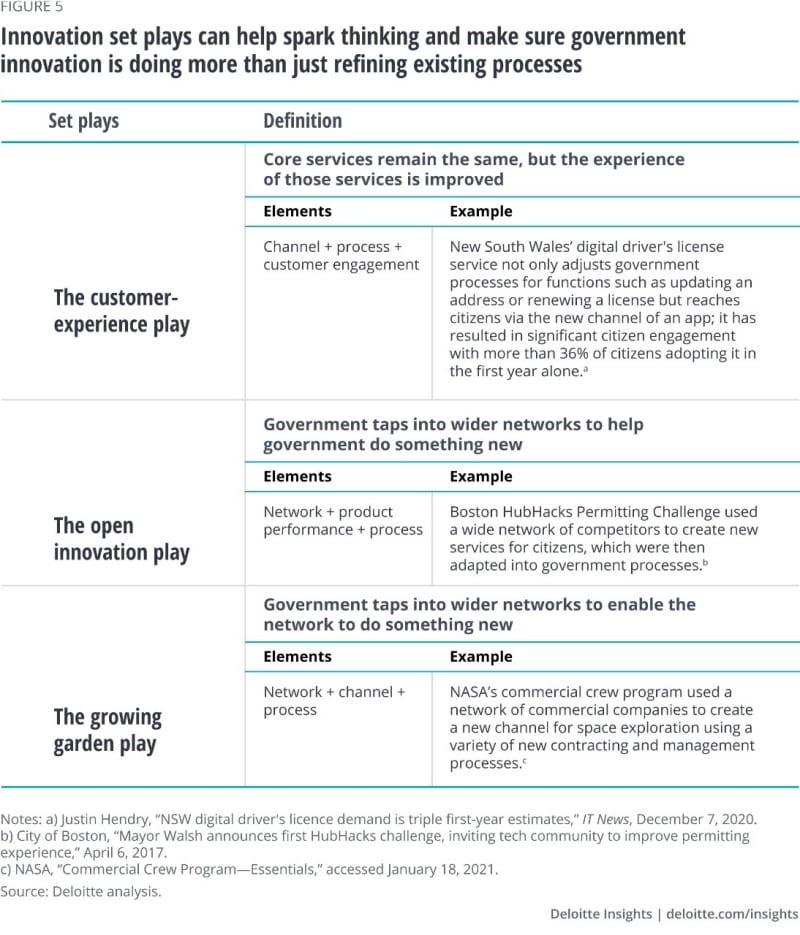Overcome mental challenges
Uncover the “job to be done” that the public needs
Perhaps the strongest challenges to finding new ways of doing business are the preconceived notions about how work needs to be done. Once government selects a service delivery model to meet a particular need, it can lead to a sort of mental “lock-in” where leaders assume that the need can only be met by that service in that particular form. For example, in the late 19th and early 20th centuries, public libraries began to spread around the world with the goal of promoting culture and education among citizens. The means of achieving this goal was housing and lending books. This led many libraries to consider lending books at the core of their mission. Yet, shifting trends in where citizens find information mean that now, people are about as likely to use the library for Wi-Fi as for books.17 As these trends continue to shift, the library’s goals of education and cultural enrichment may be better met by meetings and classes, or by becoming a trusted verifier of information in today’s environment of mis/disinformation.18
The story of libraries shifting services exemplifies how government needs to understand the “job” that citizens need done.19 Citizens do not want a government service, they want a “job” done, and government service is just one way of accomplishing that. For example, citizens don’t necessarily want a fire department, they want buildings not to burn down, and there can be many ways to accomplish that. In fact, when New York City used AI to improve building inspections, it resulted in the first month ever that saw no fire-related fatalities in the city.20 The challenge is that mental challenges (such as functional fixedness) can limit us to seeing familiar tools/services as the only way to do that particular job.21 If government leaders are going to take advantage of new technologies to meet citizens’ needs in new ways, they need tools to help them break those mental challenges and see the various ways of delivering services to citizens. Templates laying out goals and all the resources available can be valuable tools in helping government to view familiar problems from new angles and find a vision for service delivery unconstrained by “the way it’s always been done.”
Overcome technical challenges
Treat technologies together, not as disconnected tools
Technologies have never existed in splendid isolation. A nail is more or less useless without a hammer. But the convergence of today’s digital technologies has taken this to an extreme degree. As a result, government leaders should not think about purchasing just AI or only migrating to cloud, but must think about how those technologies interact and what opportunities—and what cyber vulnerabilities—they create for each other. For example, if city leaders were only to consider VR, they might discard it as a toy for gamers. But combine that same VR with a cloud-based digital twin of the city, and now you have an interactive tool for city planning or disaster response.22 This is where the innovation “set plays” discussed earlier can be especially helpful. They can help visualize how certain technologies naturally fit together.
Overcome regulatory challenges
Advocate for relief where necessary
Government is not a private company; it must manage risk not just for employees and customers, but for all citizens. Moreover, unlike a private entity, government programs are often created by statute. As a result, government can face legal constraints on what services are delivered to citizens, which citizens are to receive those services, and in some cases, how services are delivered. While most government agencies still have a wide latitude in how to best serve citizens, in the event that regulation constrains new developments, leaders should advocate for relief that can enable innovation while still protecting citizens. For example, when the Defense Innovation Board found that budgetary limitations were impacting the US Department of Defense’s ability to develop the best software for its money, it advocated a new appropriation category just for software, which Congress created at the end of 2020.23
Governments are always innovating, and the current time offers exciting new possibilities. But to make sure we make the most of these possibilities, we need to consider thinking differently and be open to entirely new models of government service delivery. Success in doing so could be the first step toward a truly digital government. Failure may look like rocket-delivered mail.





















